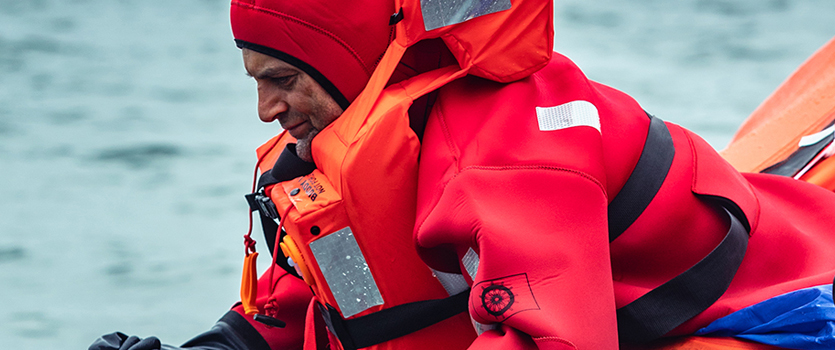An immersion suit is designed to protect the user's body from the cooling effects of unintended immersion in water to prolong life and to aid rescue. It does this by reducing the risk of cold shock and to delay the onset of hypothermia. It also makes the wearer sufficiently conspicuous in the water so as to aid their recovery. An immersion suit may also be referred to as an abandonment suit.
All immersion suits must be designed to be donned in less than 2 minutes – including any associated clothing or a lifejacket as required.
Immersion suit’s must be serviced at an approved Survitec Service Station every three years from the date of purchase. After 10 years, this service interval decreases to a service to be completed every year. In addition to this, all immersion suits are also to be inspected every month as required by SOLAS Chapter III/20.7.2. If purchased at Survitec, they must be serviced at an approved Survitec service station. Survitec service stations are audited on a regular basis to ensure our high standards are maintained.
Approximately 10 years - after this, the annual servicing requirement often renders it more economical to replace these suits.
No – Crewsaver immersion suits must be serviced at an approved Survitec service station. Survitec service stations are audited on a regular basis to ensure our high standards are maintained.
Yes, we offer SuitXChange exclusively through Survitec. In our offering, we have both pillowed or non-pillowed immersion suit options depending on your preference. This solution ensures we manage your servicing and exchange requirements that allows you to save time and cost when in port.
Survitec’s immersion suit products* are supplied under the world class brand, Crewsaver. Since July 2006, regulations* for cargo ships and bulk carriers trading outside the parallels 20 degrees north or 20 degrees south have stipulated that one fully approved immersion or abandonment suit must be carried for each crew member. The Crewsaver immersion suit range allows you to comply with these regulations.
*Outside of our USCG approved products.
**Marine Equipment Directive 96/98/EC of December 1996 SOLAS 74/78 as amended Reg. III/4, III/7, III/22, III/32, III/34, X/3 LSA Code I,II, as amended by MSC.207(81), MSC.218(82) HSC Code 1994 MSC.36(63) and HSC Code 2000 MSC.97(73), 8 IMO Resolution MSC.81(70), MSC/Circ.1046.
No - Only use the recommended suit manufacturer.
Yes - this is a requirement to meet SOLAS approvals.
Crewsaver immersion suits which feature integrated buoyancy pillows are factory fitted with a SOLAS approved light as standard. All other Crewsaver immersion suits are designed to be worn in conjunction with a SOLAS approved lifejacket which will include an integrated SOLAS approved light.
All Crewsaver neoprene immersion suits are constructed from 5mm neoprene.
Use a beeswax block and run up and down the zip teeth. This is usually done by the operator during the monthly inspection. Beeswax is not included with the immersion suit but is widely available.
No - The buoyancy from the suit’s pillow located behind the wearer’s neck will work against the lifejacket’s buoyancy placement as it inflates.
Yes. All immersion suits without an integrated buoyancy pillow are designed to be worn in conjunction with a compatible SOLAS approved lifejacket.



